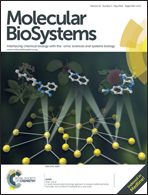A conformational analysis of mouse Nalp3 domain structures by molecular dynamics simulations, and binding site analysis†
Abstract
Scrutinizing various nucleotide-binding oligomerization domain (NOD)-like receptor (NLR) genes in higher eukaryotes is very important for understanding the intriguing mechanism of the host defense against pathogens. The nucleotide-binding domain (NACHT), leucine-rich repeat (LRR), and pyrin domains (PYD)-containing protein 3 (Nalp3), is an intracellular innate immune receptor and is associated with several immune system related disorders. Despite Nalp3's protective role during a pathogenic invasion, the molecular features and structural organization of this crucial protein is poorly understood. Using comparative modeling and molecular dynamics simulations, we have studied the structural architecture of Nalp3 domains, and characterized the dynamic and energetic parameters of adenosine triphosphate (ATP) binding in NACHT, and pathogen-derived ligands muramyl dipeptide (MDP) and imidazoquinoline with LRR domains. The results suggested that walker A, B and extended walker B motifs were the key ATP binding regions in NACHT that mediate self-oligomerization. The analysis of the binding sites of MDP and imidazoquinoline revealed LRR 7–9 to be the most energetically favored site for imidazoquinoline interaction. However, the binding free energy calculations using the Molecular Mechanics/Poisson–Boltzmann Surface Area (MM/PBSA) method indicated that MDP is incompatible for activating the Nalp3 molecule in its monomeric form, and suggest its complex interaction with NOD2 or other NLRs accounts for MDP recognition. The high binding affinity of ATP with NACHT was correlated to the experimental data for human NLRs. Our binding site prediction for imidazoquinoline in LRR warrants further investigation via in vivo models. This is the first study that provides ligand recognition in mouse Nalp3 and its spatial structural arrangements.


 Please wait while we load your content...
Please wait while we load your content...